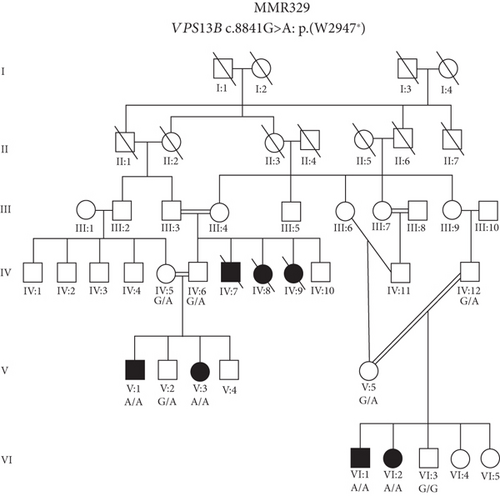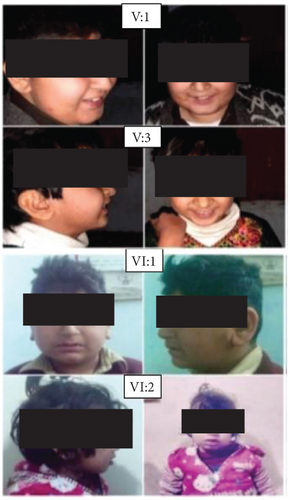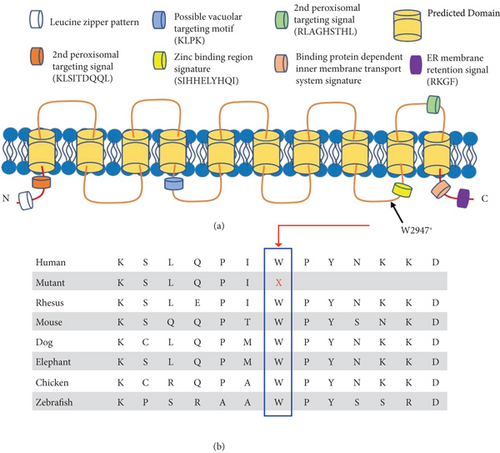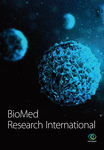A Novel Variant in VPS13B Underlying Cohen Syndrome
Abstract
Pathogenic variants in vacuolar protein sorting 13 homolog B (VPS13B) cause Cohen syndrome (CS), a clinically diverse neurodevelopmental disorder. We used whole exome and Sanger sequencing to identify disease-causing variants in a Pakistani family with intellectual disability, microcephaly, facial dysmorphism, neutropenia, truncal obesity, speech delay, motor delay, and insomnia. We identified a novel homozygous nonsense variant c.8841G > A: p.(W2947 ∗) in VPS13B (NM_017890.5) which segregated with the disease. Sleep disturbances are commonly seen in neurodevelopmental disorders and can exacerbate medical issues if left untreated. We demonstrate that individuals with Cohen syndrome may also be affected by sleep disturbances. In conclusion, we expand the genetic and phenotypic features of Cohen syndrome in the Pakistani population.
1. Introduction
Cohen syndrome (CS) is a rare heritable autosomal recessive disorder that includes intellectual disability (ID), developmental delay, microcephaly, and hypotonia. Myopia and retinal dystrophy are additional common characteristics, but hypermobility, facial dysmorphism, and a bulbous nasal tip are rarer features [1]. Cohen syndrome has a wide range of clinical characteristics among those who are affected. Additional signs and symptoms in certain people with this syndrome include neutropenia, autistic-like features, and truncal obesity. Affected individuals may also have small hands, feet, and fingers [2]. CS is diagnosed at a frequency of 0.7% in individuals with unexplained intellectual disability [3].
CS is caused by variants in VPS13B (also known as COH1), which codes for vacuolar protein sorting 13 homolog B. It is a 4022-amino-acid transmembrane protein that is located on chromosome 8 (8q22.2). The protein encoded by this gene is a Golgi-associated peripheral membrane protein involved in Golgi integrity and homeostasis, as well as membrane transport and it is a member of the VPS13 protein family, which is extremely well preserved in eukaryotic cells [4]. Chorea acanthocytosis (OMIM: 200150), rapidly progressive, early-onset autosomal recessive Parkinson’s disease (OMIM: 616840), and spinocerebellar ataxia, autosomal recessive 4 (OMIM: 607317) are all possible outcomes of loss of function variants in other VPS13 family members [5].
With the fast advancement of high-throughput sequencing technology, exome sequencing has enabled patients with subtle clinical symptoms to get an early and precise molecular diagnosis, thereby enhancing patient quality of life and simplifying genetic counseling [6]. Due to its massive benefits such as high efficiency, cost, and high accuracy, exome sequencing has been widely used in clinical practice and research [7]. In this study, we investigated a large consanguineous pedigree with ID from Pakistan via exome sequencing.
2. Methods
This research was performed in accordance with the Declaration of Helsinki. Ethical approval for the study was obtained from the Institutional Review Board (IRB) of the involved institutions, the International Islamic University Islamabad (IIUI/BIBT/FBAS-2022/77) and Columbia University (IRB-AAAS3433). Informed consent was obtained from healthy adult subjects, the parents/legal guardians of minor subjects, and the ID patients in this study to publish the findings of the study.
2.1. Clinical Assessment
A large consanguineous family with ID (MMR-329) of Pashtun ancestry was ascertained in Pakistan (Figure 1(a)). Pedigree information was recorded up to six generations, with a total of seven affected individuals of whom three (IV : 7, IV : 8, and IV : 9) are deceased. Living affected individuals were examined by a local neurologist and psychiatrist (Figure 1(b)). The phenotypic information of all affected members of the family was noted in detail (Table 1) which included age, sex, height, ID, facial dysmorphism, developmental delay, and psychomotor delay features.


| Patient features | V : 1 | V : 3 | VI : 1 | VI : 2 |
|---|---|---|---|---|
| Sex | Male | Female | Male | Female |
| Consanguinity of parents | First cousin | First cousin | ||
| Age (years) | 13 | 7 | 14 | 5 |
| Height (cm) | 150 | 117 | 136 | 88 |
| Age at first words (months) | 20 | 19 | 20 | 19 |
| Age at walking (months) | 32 | 28 | 33 | 28 |
| Intellectual disability | Moderate | Moderate | Moderate | Moderate |
| Microcephaly | + | + | + | + |
| Neutropenia | + | + | + | + |
| Hypotonia | - | - | - | + |
| Motor delay | - | - | + | + |
| Speech delay | + | + | + | + |
| Muscular atrophy | - | - | - | + |
| Insomnia/sleep disturbances | - | - | - | + |
| Neonatal feeding difficulties | + | + | + | + |
| Strabismus | + | - | - | + |
| Wave shape eyelid | + | + | + | + |
| Long and thick eyelashes | + | + | + | + |
| Large ear | + | + | + | + |
| Prominent nose root | + | + | + | + |
| Prominent upper central incisors | + | + | + | + |
| Narrow roof mouth | + | + | + | + |
| Short philtrum | + | + | + | + |
| Truncal obesity | + | + | + | + |
| Small hands, feet, and fingers | - | + | - | + |
- + Present, - absent.
2.2. Exome Sequencing
The extraction of genomic DNA was done from the blood of the patients and unaffected members of the family by standard organic methods of phenol-chloroform for genetic analysis. DNA samples from two patients (V : 3 and VI : 1) were exome sequenced using the Twist+RefSeq library preparation kit (Twist Bioscience, San Francisco, CA, USA). Barcoded libraries were pooled, and sequencing was performed on the NovaSeq 6000 (Illumina Inc., San Diego, CA, USA) with an average on-target coverage of 40X.
2.3. Bioinformatic Analysis
Reads were aligned to GRCh37/hg19 using the Burrows-Wheeler aligner (BWA) [8]. Duplicate removal, indel-realignment, quality recalibration, and variant detection and calling were performed using Picard and the genome analysis toolkit (GATK) following the GATK best practices workflows [9]. Variants were annotated using ANNOVAR [10]. The criteria for variant selection included a minor allele frequency (MAF) of <0.005 in each population of gnomAD [11], a CADD-Phred score of >20 for missense variants, exonic variants, splice sites (±12 bp), and fitting an inheritance model consistent with the pedigree (autosomal recessive) [12]. Bioinformatic prediction tools were used to evaluate the effect of the variant on the protein (Table 2). These tools included MutationTaster [13], FATHMM-MKL [14], DANN [15], LRT-Pred [16], CADD [17], GERP [18], and VEST4 [19].
| Bioinformatic tool | Prediction | Score | Prediction range |
|---|---|---|---|
| MutationTaster | Disease causing | 1 | 0-1 (close to 1 indicating disease causing) |
| FATHM-MKL | Damaging | 0.998 | 0-1 (close to 1 indicating damaging) |
| DANN | Damaging | 0.996 | 0-1 (close to 1 indicating damaging) |
| LRT-Pred | Deleterious | 0.860 | 0-1 (close to 1 indicating deleterious) |
| CADD | Deleterious | 45 | 1-99 (>20 deleterious) |
| GERP | Deleterious | 5.98 | >4 highly conserved (deleterious) |
| VEST4 | Mutated | 0.861 | 0-1 (close to 1 indicating the functional mutation |
2.4. Sanger Sequencing
The VPS13B variant from the WES data was validated by Sanger sequencing and tested in additional family members to confirm its segregation with the disease. Primers were designed through Primer3 (https://bioinfo.ut.ee/primer3-0.4.0/). PCR-amplified products were purified by ExoSAP-IT (USB Corp., Cleveland, OH, USA) and were sequenced using the BigDye Terminator v3.1 Cycle Sequencing Kit followed by capillary electrophoresis on an ABI 3730 DNA Analyzer (Applied Biosystems Inc., Foster City, CA USA). The DNA sequences were then aligned to the reference genome sequence using the CodonCode Aligner v7.1.2 (CodonCode Corp., Centerville, MA, USA).
3. Results
3.1. Clinical Findings
A description of the features seen in each affected individual (V : 1, V : 3, VI : 1, and VI : 2) is listed in detail in Table 1. Briefly, these individuals presented with ID and other clinical features including microcephaly, neutropenia, facial dysmorphism, developmental delay, psychomotor delay, a bulbous nasal tip, truncal obesity, small hands, feet, and fingers. One patient (VI : 2) of this CS family showed additional features including hypotonia, muscle atrophy, and insomnia.
3.2. Exome Sequencing and Follow-Up
Exome sequencing of two affected individuals (V : 3 and VI : 1) in the family revealed a novel homozygous nonsense variant c.8841G > A (NM_017890.5) located in exon 48 out of 62 in the VPS13B gene (Supplementary Figure 1b) at position 8q22.2 (Supplementary Figure 1a). The variant altered the tryptophan amino acid into a premature stop codon p.(W2947 ∗). The average on-target coverage was 40x, and 24x and 33x at the VPS13B c.8841G > A site for both exomed individuals. Sanger sequencing verified the segregation of this variant in the pedigree (Supplementary Figure 1c). This novel nonsense mutation is absent in gnomAD [20], 1000 genomes [21], GME Variome [22], Kaviar [23], ABraOM [24], AllofUs [25], and TOPMed [26], and bioinformatic tools predict that it significantly damages the function of the VPS13B protein (Table 2). A protein alignment of amino acid sequence 2941 to 2953 of the wild-type human and mutant VPS13B with orthologous proteins of the different species indicated an evolutionary conserved of the C-terminal domain (Figure 2(b)), and the GERP++RS score was 5.98 (Table 2). The variant was classified as pathogenic based on standard guidelines of the American College of Medical Genetics (ACMG) [27].

4. Discussion
CS is a rare autosomal recessive disorder mainly characterized by ID, impaired growth, microcephaly, neutropenia, truncal obesity, and facial dysmorphism, with other additional features including myopia and retinal dystrophy, small fingers, and a bulbous nasal tip [28]. In this study, we observed phenotypic diversity among the affected individuals of the same family which includes motor delay (VI : 1 and VI : 2), strabismus (V : 1 and VI : 2), and hypotonia, muscle atrophy, and insomnia (VI : 2). Furthermore, all affected individuals manifested characteristic CS features including moderate ID, microcephaly, neutropenia, developmental delay, truncal obesity, a bulbous nasal tip, small fingers, and facial dysmorphism. Previous studies in Pakistani consanguineous families underlying CS have described additional features associated with Cohen syndrome including cerebellar hypoplasia [29], autistic-like features [30], and individuals with a milder form of CS [31]. Moreover, in the present study, we found a previously undescribed feature (insomnia) in CS in the affected individual (VI : 2). This individual has difficulty falling asleep, repeated awakenings with difficulty returning to sleep, or sleep that is nonrestorative or poor in quality. Sleep disturbances such as insomnia are a common feature in many neurodevelopmental disorders (NDDs) [32] such as the Angelman syndrome (AS), autism spectrum disorder (ASD), the Smith-Magenis syndrome (SMS), the Prader-Willi syndrome (PWS), tuberous sclerosis complex (TSC) [33], Fragile X syndrome (FXS), the Williams syndrome (WS), and the Rett syndrome (RTT). Not only are sleep disturbances significantly higher in NDDs than in age-matched unaffected children but they also often last longer as well, such as into adolescence and adulthood [32]. Untreated sleep disorders can aggravate their medical issues, and early interventions may be beneficial to the patient’s overall health.
In this study, we report a novel genetic variant in VPS13B [NM_017890.5, c.8841G > A: p.(W2947 ∗)] in an autosomal recessive consanguineous Pakistani CS family. Over 200 variants have been reported worldwide in multiple domains of VPS13B associated with CS [34]. VPS13B protein has ten transmembrane domains and a potential vacuolar targeting motif, an endoplasmic reticulum retention signal on the C-terminus and two peroxisomal matrix protein targeting signal 2 (PTS2) consensus sequence both on the N- and C-terminus (Figure 2(a)) [35]. Our nonsense variant resides in between the 8th and 9th transmembrane domains of VPS13B, and at this position, the variant is likely targeted via nonsense mRNA-mediated decay (NMD), resulting in no or limited truncated protein expression.
In conclusion, we report a novel nonsense variant in VPS13B associated with CS in a large Pakistani family which displayed phenotypic variability and an expanded phenotype. This study will help facilitate the diagnosis and genetic counseling of families with CS-related features in the Pakistani population.
Abbreviations
-
- VPS13B:
-
- Vacuolar protein sorting 13 homolog B
-
- CS:
-
- Cohen syndrome
-
- WES:
-
- Whole exome sequencing
-
- ID:
-
- Intellectual disability
-
- COH1:
-
- Cohen syndrome 1
-
- OMIM:
-
- Online Mendelian Inheritance in Man
-
- NGS:
-
- Next generation sequencing
-
- DNA:
-
- Deoxyribonucleic acid
-
- BWA:
-
- Burrows-Wheeler aligner
-
- GATK:
-
- Genome analysis tool kit
-
- ANNOVAR:
-
- Annotate variation
-
- MAF:
-
- Minor allele frequency
-
- CADD:
-
- Combined annotation-dependent depletion
-
- DANN:
-
- Deleterious annotation of genetic variants using neural networks
-
- GERP:
-
- Genomic evolutionary rate profiling
-
- VEST:
-
- Variant effect scoring tool
-
- PCR:
-
- Polymerase chain reaction
-
- gnomAD:
-
- Genome aggregation database
-
- GME:
-
- Greater Middle East
-
- Kaviar:
-
- Known variants
-
- ABraOM:
-
- Brazilian genomic variants
-
- TOPMed:
-
- Trans-Omics for Precision Medicine
-
- AS:
-
- Angelman syndrome
-
- ASD:
-
- Autism spectrum disorder
-
- SMS:
-
- Smith-Magenis syndrome
-
- PWS:
-
- Prader-Willi syndrome
-
- TSC:
-
- Tuberous sclerosis complex
-
- FXS:
-
- Fragile X syndrome
-
- WS:
-
- Willian syndrome
-
- RTT:
-
- Rett syndrome
-
- C:
-
- Carbon
-
- N:
-
- Nitrogen
-
- PTS2:
-
- Protein targeting signal 2
-
- NMD:
-
- Nonsense mediated decay
-
- ACMG:
-
- American College of Medical Genetics.
Conflicts of Interest
The authors declare they have no conflicts of interest.
Authors’ Contributions
Asif Mir and Isabelle Schrauwen contributed equally to this work.
Acknowledgments
We are thankful to the affected individuals and their families for their volunteer participation. AH is supported by a Higher Education Commission of Pakistan Research Support Fellowship. Exome sequencing was provided by the University of Washington Center for Mendelian Genomics (UW-CMG) and was funded by NHGRI and NHLBI grants UM1 HG006493 and U24 HG008956. The content is solely the responsibility of the authors and does not necessarily represent the official views of the National Institutes of Health.
Open Research
Data Availability
The datasets used and/or analysed during the current study are available from the corresponding authors on reasonable request. The variant identified in this study has been deposited into ClinVar (SCV002564668). Bio workflows used are available at https://github.com/cumc/bioworkflows.




